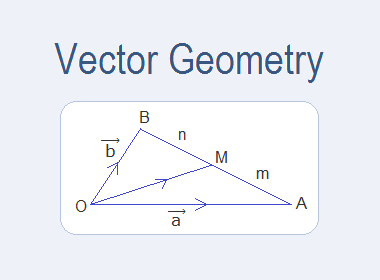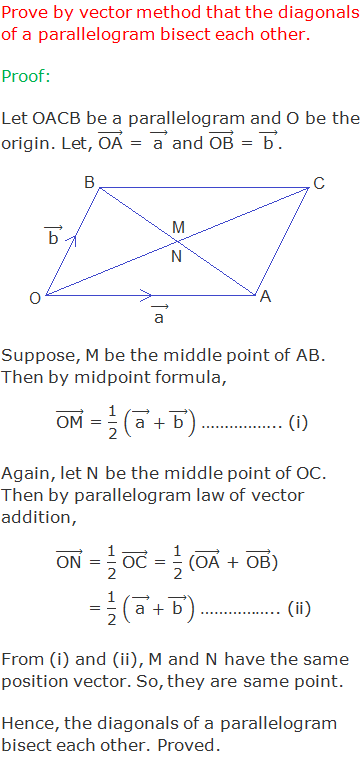
Vector Geometry: We can study different properties and relations relating to geometry with the help of vectors. Such a study is known as the Vector Geometry.
********************
10 Math Problems officially announces the release of Quick Math Solver and 10 Math Problems, Apps on Google Play Store for students around the world.
********************
********************
Here are 12 geometrical theorems and
their proofs by vector method.
Theorem 1: Midpoint Formula

Theorem 2: Section Formula for Internal Division

Theorem 3: Section Formula: External Division

Theorem 4: Centroid Formula

Theorem 5:

Theorem 6:
![Theorem 6: Prove by vector method that the line joining vertex and midpoint of the base of an isosceles triangle is perpendicular to the base. Proof: Let ABC be an isosceles triangle where AB = AC and AM is the median to the base BC. Let ("AB" ) ⃗ = ( "a" ) ⃗ and ("AC" ) ⃗ = ( "b" ) ⃗. Then, |( "a" ) ⃗| = |( "b" ) ⃗| i.e. a = b. And, ("BM" ) ⃗ = "1" /"2" ("BC" ) ⃗ By triangle law of vector addition, ("BC" ) ⃗ = ("BA" ) ⃗ + ("AC" ) ⃗ = – ("AB" ) ⃗ + ("AC" ) ⃗ = – (" a " ) ⃗ + (" b " ) ⃗ = ((" b " ) ⃗ – (" a " ) ⃗) ("AM" ) ⃗ = ("AB" ) ⃗ + ("BM" ) ⃗ = ("AB" ) ⃗ + "1" /"2" ("BC" ) ⃗ = (" a " ) ⃗ + "1" /"2" (– (" a " ) ⃗ + (" b " ) ⃗) = ("2" ( "a" ) ⃗ - ( "a" ) ⃗ + ( "b" ) ⃗)/"2" = (( "a" ) ⃗ + ( "b" ) ⃗)/"2" = "1" /"2" ((" a " ) ⃗" +" (" b " ) ⃗ ) Now, ("AM" ) ⃗ . ("BC" ) ⃗ = "1" /"2" ((" a " ) ⃗" +" (" b " ) ⃗ ) . ((" b " ) ⃗ – (" a " ) ⃗) = "1" /"2" (b2 – a2) = 0 [∵ a = b] ∴ AM ⊥ BC proved.](https://blogger.googleusercontent.com/img/b/R29vZ2xl/AVvXsEiLm_HIZzIWPeZE9FxRm0gWYhTKq99q7FQvwYTnCKE8UKwiWFdmBU7yqVV-AnHaea0cBN9deVyDRKRn_rZGAd3yc0U0ZVEQHQUFSRedjgcurGBV3NvIW0RLN1FJRta2hOTkby8Fv3go8768/s16000/theorem+6.png)
Theorem 7:

Theorem 8:

Theorem 9:

Theorem 10:
![Theorem 10: Prove by vector method that the diagonals of a rhombus bisect each other at right angles. Proof: Let OABC is a rhombus, ("OA" ) ⃗ = ("CB" ) ⃗ = (" a " ) ⃗ and ("OC" ) ⃗ = ("AB" ) ⃗ = (" b " ) ⃗ where |(" a " ) ⃗| = |(" b " ) ⃗| i.e. a = b. Let M be the midpoint of diagonal OB and N is the midpoint of diagonal AC. Now, by triangle law of vector addition, ("OB" ) ⃗ = ("OA" ) ⃗ + ("AB" ) ⃗ = (" a " ) ⃗ + (" b " ) ⃗. Since, M is the midpoint of OB, ("OM" ) ⃗ = "1" /"2" ("OB" ) ⃗ = "1" /"2" ((" a " ) ⃗ + (" b " ) ⃗) ………….. (i) Again, since N is the midpoint of AC, by midpoint theorem, ("ON" ) ⃗ = "1" /"2" (("OA" ) ⃗ + ("OC" ) ⃗) = "1" /"2" ((" a " ) ⃗ + (" b " ) ⃗) ………….. (ii) From (i) and (ii), the midpoints M and N of diagonals OB and AC coincide each other, i.e. they are the same point. Hence, the diagonals of a rhombus bisect each other. Now, ("AC" ) ⃗ . ("OB" ) ⃗ = (–( "a" ) ⃗ + ( "b" ) ⃗ ) . (( "a" ) ⃗ + ( "b" ) ⃗) = ((" b " ) ⃗)2 – ((" a " ) ⃗)2 = b2 – a2 = 0 [∵ a = b] ∴ ("AC" ) ⃗ ⊥ ("OB" ) ⃗. Hence diagonals of a rhombus bisect each other at right angle. Proved.](https://blogger.googleusercontent.com/img/b/R29vZ2xl/AVvXsEgs9FJlJlaqmLPk6Ct5V5GEF_83EhZIH5pGWAKarpe-OKuljwYb3qA8aJysiLSidFElq3rZGyScjHhcB2lY-A2kpl1icukHUvhEKE4YYVBkj6TNeIIYZtKRN63mxs4eJ2elx3qnj4F_5nnS/s16000/theorem+10.png)
Theorem 11:
![Theorem 11: Prove by vector method that the angle in the semi-circle is a right angle. Proof: Let O be the centre of a circle and AB be a diameter. ∴ ("AO" ) ⃗ = ("OB" ) ⃗. ∠ACB is an angle in the semi-circle. Join OC. AO = OB = OC (Radii of same circle). By triangle law of vector addition, ("AC" ) ⃗ = ("AO" ) ⃗ + ("OC" ) ⃗ ("CB" ) ⃗ = ("CO" ) ⃗ + ("OB" ) ⃗ = ("CO" ) ⃗ + ("AO" ) ⃗ = ("AO" ) ⃗ – ("OC" ) ⃗ Now, ("AC" ) ⃗ . ("CB" ) ⃗ = ((AO) ⃗+(OC) ⃗ ) . (("AO" ) ⃗ – ("OC" ) ⃗) = (("AO" ) ⃗)2 – (("OC" ) ⃗)2 = AO2 – OC2 = 0 [∵ AO = OC] ∴ ∠ACB = 90°. Proved.](https://blogger.googleusercontent.com/img/b/R29vZ2xl/AVvXsEjIxQib3jHHm9Sx-gTmVgiK-fNAnzSJnssnMo1XtmiwA1SqAZxFwJvJe9tEVWFkk1Qxc0HOFOS1B3KDCpf8cCecQiWlCIfj2RdJUaDqRPO_y7yrllFuHUa2J1Fb0mhVGtx135VN7VQaCT3H/s16000/theorem+11.png)
Theorem 12:

Do you have any questions regarding the vector geometry?
You can ask your questions or problems here, in the comment section below.



0 comments: